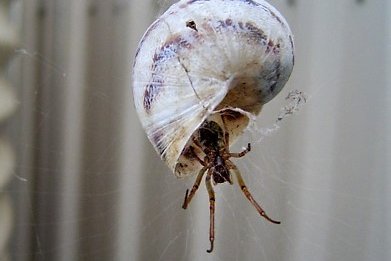How do worms know where to settle?

© Conrad Helm
The start of a sedentary marine worm's life is a bit of a mystery. How do they end up choosing where to live out their days?
Many polychaetes have tiny larvae that spend weeks swimming in the water column. How exactly they make the crucial decision where to settle and become sedentary adults, with very restricted distribution, is still a matter of a debate. Some polychaete species are gregarious, like the “Sydney coral” Galeolaria which forms a distinct zone on rocky shores around Sydney, whereas many others are solitary. Most polychaetes are relatively slow moving as adults and they have the potential to disperse hundreds, if not thousands of kilometres only during the pelagic larval stage.
Recently we have been raising the larvae of the sabellariid polychaete Idanthyrsus australiensis which occurs around much of Australia’s coast as solitary individuals living in sandy tubes cemented underneath intertidal rocks. We collected worms in early January at Long Reef in Collaroy , and back in the laboratory we removed the worms from the tubes. Some of them were clearly mature males and females, as was evident by orange egg-filled and white sperm-filled abdomens and spawned spontaneously. We mixed the gametes, successfully fertilised them, and for the next 4 weeks kept larvae in a constant temperature (around 18°C) in the laboratory at University of Sydney, feeding them on an algal culture and changing their water daily. During these four weeks, we regularly sampled the larvae and fixed some for further studies. After four weeks, we found swimming larvae turned overnight into juveniles clumped together on the bottom of the beaker. They lost their long swimming chaetae (chitinous bristles), developed long paired appendages (palps ), and formed a mucous tube (see video). Both larvae and juveniles are now being investigated using light and scanning electron microscopy, as well as immunohistochemical staining, a sophisticated technique that allows telling apart different proteins by colouring and directly observing them under a specialized microscope.

© Australian Museum
So why did we choose this particular species from this particular worm family? The family Sabellariidae is an ideal candidate for investigating the mechanism of larval settlement in polychaetes as this family occurs throughout the world from the intertidal zone to the deep ocean. Among 12 genera known, some are exclusively gregarious or solitary, but others include both solitary and gregarious species. A recent study (Faroni-Perez et al. 2016) looked at the larvae of a gregarious sabellariid Sabellaria alveolata, which forms extensive reefs in northern Europe made of masses of sandy tubes. The study has examined a well-developed, but mysterious structure located in between the palps and referred to as the medial organ. Faroni-Perez et al. (2016) reviewed the morphology of the adult medial organ within the family based on the literature and found considerable variation. By tracking development of Sabellaria alveolata from fertilisation to juvenile stages, they showed how the medial organ is formed from a dorsal hump and how many nerves are attached to it, strongly suggesting that is has a sensory function. So, the question is whether the development of the medial organ from the dorsal hump is similar in solitary species having this medial organ as adults.
We started addressing this question by rearing the larvae of the Australian species Idanthyrsus australiensis. This species can occur either as solitary individuals at Long Reef or as small colonies of 10-15 individuals up on the north coast of NSW. We know from DNA analysis (Faroni-Perez et al. 2016) that these populations represent the same species. Now we are now embarking on the next stage. The fixed larvae and newly settled juveniles are on their way to Bergen, Norway, where the innervation of the dorsal hump and its development into the adult medial organ will be studied by our collaborators. Other fixed larvae were sent to Madrid to be examined under the SEM and one of the attached images is from these photos. We are looking forward to the next stage of this project.
Use of techniques like immunochemistry to study development of larval polychaetes and potentially the use of florescent photography is beginning to reveal possible ways in which polychaete larvae may be able to detect suitable places to settle and to find other individuals of the same species for gregarious species. Perhaps it is fortunate that many of these species produce thousands of eggs – just as well, considering the lottery like chances of finding somewhere suitable to settle.
This study has also highlighted the potential importance of describing the medial organ when describing new species of sabellariids, something often neglected in the past. The structure of the medial organ may provide additional insights into the phylogeny of this family. It may also help to explain why some genera are entirely abyssal, but others are found from the intertidal to great depths and why some species are gregarious while others are solitary.
Dr Elena Kupriyanova, AMRI Research Scientist
Dr Pat Hutchings, AMRI Senior Fellow













